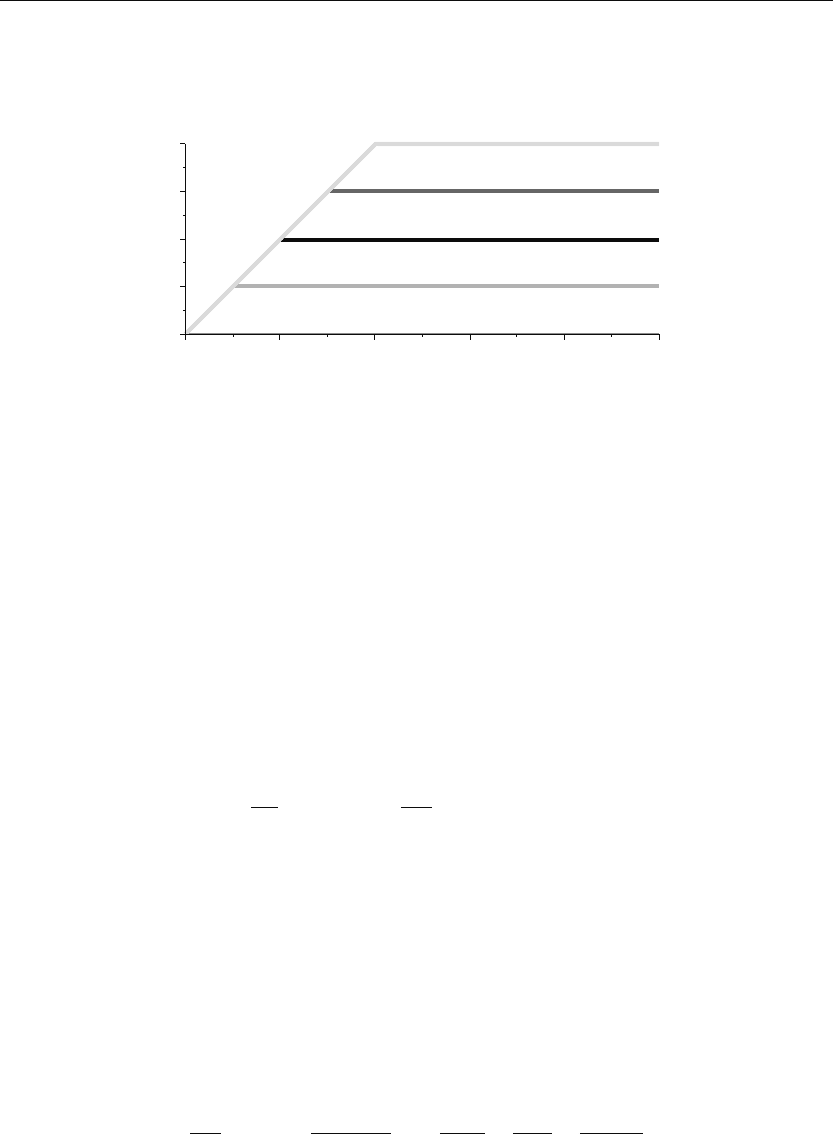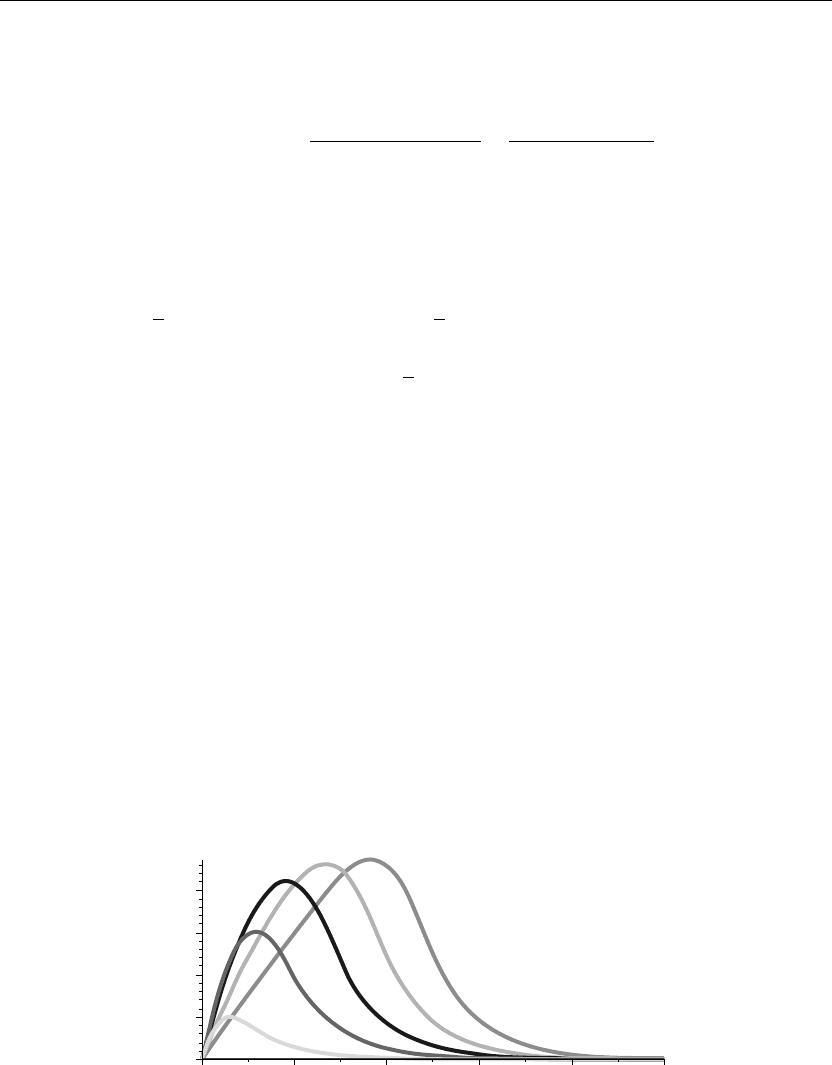Articolo G.A. Partial Differential Equations and Boundary Value Problems with Maple V
Подождите немного. Документ загружается.


688 Chapter 10
General solution
> U(x,s):=C1(s)*exp(−s/c*x)+C2(s)*exp(s/c*x)+Up(x,s);
U(x∼,s):= C1(s) e
−sx∼
+C2(s) e
sx∼
+
e
−s
s
2
(10.158)
Substituting the boundary conditions at x = 0 and as x approaches infinity, for Re{s} > 0,
we get
> C2(s):=0;
C2(s) := 0 (10.159)
> eq:=Q(s)=eval(subs(x=0,U(x,s)));
eq := 0 = C1(s) +
e
−s
s
2
(10.160)
> C1(s):=solve(eq,C1(s));
C1(s) := −
e
−s
s
2
(10.161)
Transformed solution for U(x, s)
> U(x,s):=eval(U(x,s));
U(x∼,s):= −
e
−s
e
−sx∼
s
2
+
e
−s
s
2
(10.162)
Solution is the inverse Laplace of U(x, s)
> u(x,t):=invlaplace(U(x,s),s,t);
u(x∼,t):= −Heaviside(t −1 −x∼)(t −1 −x∼) +Heaviside(t −1)(t −1) (10.163)
ANIMATION
> animate(u(x,t),x=0..12,t=0..5,thickness=3);
The preceding animation command shows the spatial-time wave amplitude distribution u(x, t)
in the bar. The animation sequence here and in Figure 10.12 shows snapshots of the animation
at times t = 0, 1, 2, 3, 4, 5.
ANIMATION SEQUENCE
> u(x,0):=subs(t=0,u(x,t)):u(x,1):=subs(t=1,u(x,t)):
> u(x,2):=subs(t=2,u(x,t)):u(x,3):=subs(t=3,u(x,t)):

Laplace Transform Methods for Partial Diff erential Equations 689
> u(x,4):=subs(t=4,u(x,t)):u(x,5):=subs(t=5,u(x,t)):
> plot({u(x,0),u(x,1),u(x,2),u(x,3),u(x,4),u(x,5)},x=0..10,thickness=10);
4
3
2
1
0
0246810
x~
Figure 10.12
Note that for times t<1, the longitudinal displacements of the bar are zero because the
impulse does not occur until time t = 1.
EXAMPLE 10.7.7: (String with external applied force) We seek the wave amplitude
u(x, t) for transverse wave motion along a taut string over the semi-infinite interval
I ={x |0 <x<∞}. The left end of the string is held fixed. The string has the initial
displacement distribution f(x) = 0 and the initial speed distribution g(x) = 0. An external
applied force h(x, t), given following, acts on the system. There is no damping in the system,
and the wave speed is c = 1.
SOLUTION: The nonhomogeneous wave partial differential equation is
∂
2
∂t
2
u(x, t) = c
2
∂
2
∂x
2
u(x, t)
+h(x, t)
The boundary conditions are
u(0,t)= 0 and u(∞,t)<∞
The initial conditions are
u(x, 0) = 0 and u
t
(x, 0) = 0
The Laplace transformed equation reads
∂
2
∂x
2
U(x, s) −
s
2
U(x, s)
c
2
=−
sf ( x )
c
2
−
g(x)
c
2
−
H(x, s)
c
2

690 Chapter 10
Here, U(x, s) is the Laplace transform of u(x, t) with respect to t. The transformed boundary
conditions are
U(0,s)= Q(s) and U(∞,s)<∞
Assignment of system parameters
> restart:with(plots):with(inttrans):c:=1:q(t):=0:f(x):=0:f(v):=subs(x=v,f(x)):g(x):=0:
g(v):=subs(x=v,g(x)):h(x,t):=exp(−x)*t*exp(−t):
Transformed equation in x reads
> diff(U(x,s),x,x)−sˆ2/cˆ2*U(x,s)=−s*f(x)/cˆ2−g(x)/cˆ2−H(x,s)/cˆ2;
∂
2
∂x
2
U(x, s) −s
2
U(x, s) =−H(x, s) (10.164)
Transformed boundary conditions
> Q(s):=Int(q(t)*exp(−s*t),t=0..infinity);
Q(s) :=
∞
0
0dt (10.165)
> Q(s):=value(%);
Q(s) := 0 (10.166)
Transformed source term
> H(x,s):=Int(h(x,t)*exp(−s*t),t=0..infinity);
H(x, s) :=
∞
0
e
−x
t e
−t
e
−st
dt (10.167)
> H(x,s):=laplace(h(x,t),t,s);H(v,s):=subs(x=v,H(x,s)):
H(x, s) :=
e
−x
(1 +s)
2
(10.168)
Basis vectors
> assume(x>0):phi[1](x,s):=exp(−s/c*x);phi[1](v,s):=subs(x=v,phi[1](x,s)):
phi[2](x,s):=exp(s/c*x);phi[2](v,s):=subs(x=v,phi[2](x,s)):
φ
1
(x∼,s):= e
−sx∼
φ
2
(x∼,s):= e
sx∼
(10.169)

Laplace Transform Methods for Partial Diff erential Equations 691
Evaluation of the Wronskian
> W(phi[1](v,s),phi[2](v,s)):=simplify(phi[1](v,s)*diff(phi[2](v,s),v)
−phi[2](v,s)*diff(phi[1](v,s),v));
W( e
−sv
, e
sv
) := 2s (10.170)
Evaluation of the Green’s function
> G(x,v,s):=(phi[1](v,s)*phi[2](x,s)−phi[1](x,s)*phi[2](v,s))/W(phi[1](v,s),phi[2](v,s));
G(x∼,v,s):=
1
2
e
−sv
e
sx∼
− e
−sx∼
e
sv
s
(10.171)
Particular solution
> Up(x,s):=−Int(G(x,v,s)*(s*f(v)+g(v)+H(v,s))/cˆ2,v);
Up(x ∼,s):= −
1
2
( e
−sv
e
sx∼
− e
−sx∼
e
sv
) e
−v
s(1 +s)
2
dv
(10.172)
> Up(x,s):=simplify(subs(v=x,value(%)));
Up(x ∼,s):=
e
−x∼
(1 +s)
3
(−1 +s)
(10.173)
General solution
> U(x,s):=C1(s)*exp(−s/c*x)+C2(s)*exp(s/c*x)+Up(x,s);
U(x∼,s):= C1(s) e
−sx∼
+C2(s) e
sx∼
+
e
−x∼
(1 +s)
3
(−1 +s)
(10.174)
Substituting the boundary conditions at x = 0 and as x approaches infinity, for Re{s} > 0,
we get
> C2(s):=0;
C2(s) := 0 (10.175)
> eq:=Q(s)=eval(subs(x=0,U(x,s)));
eq := 0 = C1(s) +
1
(1 +s)
3
(−1 +s)
(10.176)
> C1(s):=solve(eq,C1(s));
C1(s) := −
1
−1 −2s +2s
3
+s
4
(10.177)

692 Chapter 10
Transformed solution for U(x, s)
> U(x,s):=eval(U(x,s));
U(x∼,s):= −
e
−sx∼
−1 −2 s +2s
3
+s
4
+
e
−x∼
(1 +s)
3
(−1 +s)
(10.178)
Solution is the inverse Laplace of U(x, s)
> u(x,t):=invlaplace(U(x,s),s,t);
u(x∼,t):=
1
8
Heaviside(−t +x∼) e
t−x∼
+
1
8
e
−t+x∼
Heaviside(t −x∼)(2t
2
−4tx∼
+ 2x∼
2
+2t −2x∼+1) −
1
8
e
−x∼−t
(2t
2
+2t +1) (10.179)
ANIMATION
> animate(u(x,t),x=0..12,t=0..5,thickness=3);
The preceding animation command shows the spatial-time wave amplitude distribution u(x, t)
on the string. The animation sequence here and in Figure 10.13 shows snapshots of the
animation at times t = 0, 1, 2, 3, 4, 5.
ANIMATION SEQUENCE
> u(x,0):=subs(t=0,u(x,t)):u(x,1):=subs(t=1,u(x,t)):
> u(x,2):=subs(t=2,u(x,t)):u(x,3):=subs(t=3,u(x,t)):
> u(x,4):=subs(t=4,u(x,t)):u(x,5):=subs(t=5,u(x,t)):
> plot({u(x,0),u(x,1),u(x,2),u(x,3),u(x,4),u(x,5)},x=0..10,thickness=10);
0
0.20
0.15
0.10
0.05
0
246810
x~
Figure 10.13

Laplace Transform Methods for Partial Diff erential Equations 693
Chapter Summary
Laplace transform of a piecewise continuous exponential-order function f(t)
F(s) =
∞
0
f(t) e
−st
dt
Diffusion partial differential equation
∂
∂t
u(x, t) = k
∂
2
∂x
2
u(x, t)
+h(x, t)
Initial condition
u(x, 0) = f(x)
Laplace-transformed diffusion equation
∂
2
∂x
2
U(x, s) −
sU(x, s)
k
=−
f(x)
k
−
H(x, s)
k
Wave partial differential equation
∂
2
∂t
2
u(x, t) = c
2
∂
2
∂x
2
u(x, t)
+h(x, t)
Initial conditions
u(x, 0) = f(x) and u
t
(x, 0) = g(x)
Laplace-transformed wave equation
∂
2
∂x
2
U(x, s) −
s
2
U(x, s)
c
2
=−
sf ( x )
c
2
−
g(x)
c
2
−
H(x, s)
c
2
Transformed solution
U(x, s) =
∞
0
u(x, t) e
−st
dt
Transformed source function
H(x, s) =
∞
0
h(x, t) e
−st
dt

694 Chapter 10
Solution from inverse transform
u(x, t) =
a+i∞
a−i∞
U(x, s) e
st
2πi
ds
Partitioned transform of solution
U(x, s) = U1(x, s)U2(x, s)
Convolution integral solution
u(x, t) =
t
0
u1(x, τ)u2(x, t −τ)dτ
where u1(x, t) is the inverse transform of U1(x, s) and u2(x, t) is the inverse transform of
U2(x, s).
In this chapter, we used the Laplace transform procedure for evaluating solutions to the
diffusion and the wave partial differential equations. The spatial domains of interest here were
semi-infinite or infinite. We did not consider Laplace transform methods on finite spatial
domains because these types of problems generally give rise to having to use the more
complicated methods of complex variables and residue theory to evaluate the inverse
tranforms. For finite domains, the eigenfunction methods covered in Chapters 3, 4, 6, 7, and 8
are generally much easier to implement.
Exercises
We now consider diffusion and wave equations in a single dimension over semi-infinite
intervals with nonhomogeneous boundary conditions. The time variable of interest has the
domain {t |0 <t<∞}. Because of the possibility of a nonhomogeneous boundary condition,
the methods of Chapter 9 may fail here; thus, we use the Laplace transform method to solve
these types of problems. The Laplace transforms are taken with respect to the time variable t.
We do not consider problems over finite intervals here because the eigenfunction expansion
methods of earlier chapters are more convenient to use.
Laplace Transform Methods on the Diffusion Equation
We consider the temperature distribution along a thin rod whose lateral surface is insulated
over the semi-infinite interval I ={x |0 <x<∞} for times {t |0 <t<∞}. We allow for an

Laplace Transform Methods for Partial Diff erential Equations 695
external heat source h(x, t) to act on the system. The nonhomogeneous diffusion partial
differential equation in rectangular coordinates in a single dimension reads
∂
∂t
u(x, t) = k
∂
2
∂x
2
u(x, t)
+h(x, t)
with the initial condition u(x, 0) = f(x).
For Exercises 10.1 through 10.20, we seek solutions to the preceding equation for various
given initial and boundary conditions. Evaluate the temperature distribution u(x, t) using the
Laplace transform method with respect to the variable t. Evaluate the inverse if possible;
otherwise, use the convolution method and leave the answer in the form of a convolution
integral. When possible, generate the animated solution for u(x, t), and plot the animated
sequence for 0 <t<5.
10.1. Consider a thin rod whose lateral surface is insulated over the semi-infinite interval
I ={x |0 <x<∞}. The initial temperature distribution in the rod is given as f(x).
There is no source term in the system, and the diffusivity has the magnitude k = 1/4.
Boundary conditions:
u
x
(0,t)= 0 and u(∞,t)<∞
Initial condition:
f(x) = e
−
x
2
10.2. Consider a thin rod whose lateral surface is insulated over the semi-infinite interval
I ={x |0 <x<∞}. The initial temperature distribution in the rod is given as f(x).
There is no source term in the system, and the diffusivity has the magnitude k = 1/4.
Boundary conditions:
u(0,t)= 0 and u(∞,t)<∞
Initial condition:
f(x) = x e
−
x
2
10.3. Consider a thin rod whose lateral surface is insulated over the semi-infinite interval
I ={x |0 <x<∞}. The initial temperature distribution in the rod is given as f(x).
There is no source term in the system, and the diffusivity has the magnitude k = 1/4.
Boundary conditions:
u(0,t)= 0 and u(∞,t)<∞
Initial condition:
f(x) = sin(x)

696 Chapter 10
10.4. Consider a thin cylinder over the semi-infinite interval I ={x |0 <x<∞}
containing a fluid that has an initial salt concentration density given as f(x). There is
no source term in the system, and the diffusivity has the magnitude k = 1/4.
Boundary conditions:
u(0,t)= 0 and u(∞,t)<∞
Initial condition:
f(x) = Dirac(x −1)
10.5. Consider a thin rod whose lateral surface is insulated over the semi-infinite interval
I ={x |0 <x<∞}. The initial temperature distribution in the rod is given as f(x).
There is no source term in the system, and the diffusivity has the magnitude k = 1/4.
Boundary conditions:
u(0,t)= 0 and u(∞,t)<∞
Initial condition:
f(x) = sin(x) e
−x
10.6. Consider a thin rod whose lateral surface is insulated over the semi-infinite interval
I ={x |0 <x<∞}. The left end of the rod is constrained to a temperature
u(0,t)= q(t) given following. The initial temperature distribution in the rod is 0,
there is no source term in the system, and the diffusivity has the magnitude k = 1/4.
Boundary conditions:
u(0,t)= 5 and u(∞,t)<∞
Initial condition:
f(x) = 0
10.7. Consider a thin rod whose lateral surface is insulated over the semi-infinite interval
I ={x |0 <x<∞}. The left end of the rod is constrained to the temperature
u(0,t)= q(t) given following. The initial temperature distribution in the rod is 0,
there is no source term in the system, and the diffusivity has the magnitude k = 1/4.
Boundary conditions:
u(0,t)= sin(t) and u(∞,t)<∞
Initial condition:
f(x) = 0

Laplace Transform Methods for Partial Diff erential Equations 697
10.8. Consider a thin rod whose lateral surface is insulated over the semi-infinite interval
I ={x |0 <x<∞}. The left end of the rod is constrained to the temperature
u(0,t)= q(t) given following. The initial temperature distribution in the rod is 0,
there is no source term in the system, and the diffusivity has the magnitude k = 1/4.
Boundary conditions:
u(0,t)= e
−t
and u(∞,t)<∞
Initial condition:
f(x) = 0
10.9. Consider a thin rod whose lateral surface is insulated over the semi-infinite interval
I ={x |0 <x<∞}. The left end of the rod is constrained to a temperature
u(0,t)= q(t) given following. The initial temperature distribution in the rod is 0,
there is no source term in the system, and the diffusivity has the magnitude k = 1/4.
Boundary conditions:
u(0,t)= t e
−t
and u(∞,t)<∞
Initial condition:
f(x) = 0
10.10. Consider a thin rod whose lateral surface is insulated over the semi-infinite interval
I ={x |0 <x<∞}. The left end of the rod is constrained to the temperature
u(0,t)= q(t) given following. The initial temperature distribution in the rod is 0,
there is no source term in the system, and the diffusivity has the magnitude k = 1/4.
Boundary conditions:
u(0,t)= sin(t) e
−t
and u(∞,t)<∞
Initial condition:
f(x) = 0
10.11. Consider a thin rod whose lateral surface is insulated over the semi-infinite interval
I ={x |0 <x<∞}. The left end of the rod has the input heat flux u
x
(0,t)= q(t)
given following. The initial temperature distribution in the rod is 0, there is no
source term in the system, and the diffusivity has the magnitude k = 1/4.
Boundary conditions:
u
x
(0,t)=−5 and u(∞,t)<∞
Initial condition:
f(x) = 0
